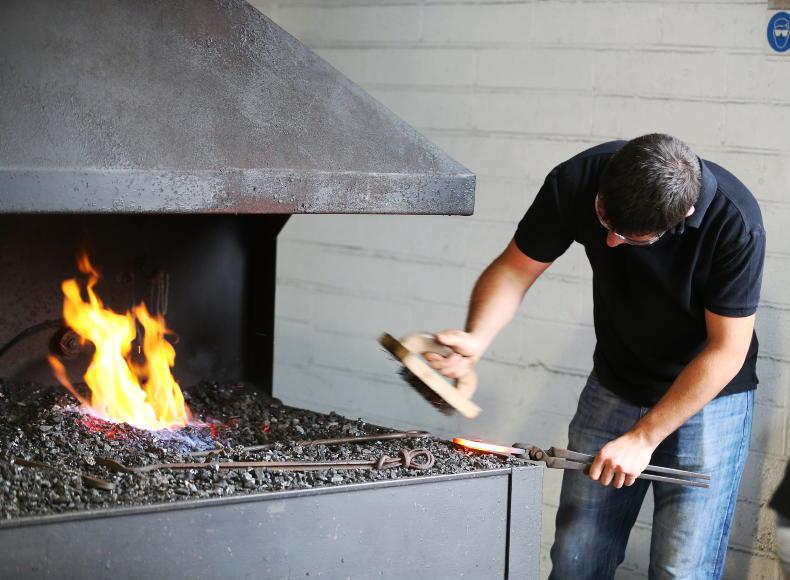Master farrier David Kelly has been a farrier for 24 years. These days he mostly specialises in competition horses and remedial farriery at Troytown Veterinary Centre. He is a member and secretary of The Irish Master Farriers Association which has over 70 members. The Irish Master Farriers Association only allows qualified master farriers to join their association. They run yearly CPD clinics for members and hold a number of seats on the Irish Farrier Authority.
Q: Is hot shoeing better for your horse than cold shoeing?
A: Hot shoeing has numerous benefits over cold shoeing. You kill bacteria where the shoe is burnt on. You have two perfectly mated surfaces so you have less movement and are therefore less likely to pull a shoe. It allows us as farriers to make alterations to the shoe that we can’t do cold. Just one example, if I am shoeing a horse that has flat feet, I can forge in an onion heel which means I use the hammer to widen the section of steel at the heel. This means when your horse is working on an arena surface, as they go through the weight bearing phase of stride, the heels will not sink as much as the toe, increasing the angle and therefore reducing the forces applied to the navicular area which is such a common area for injury in sport horses.
Q: More and more people seem to be going barefoot with their horses, including top competitors, how can you tell if your horse may be suited to barefoot?
A: Most horses are suited to barefoot. For amateurs it’s whether the set-up people have is suited to barefoot but you do have to evaluate each horse as an individual, taking into account breed, discipline and environment.
For those with competition horses, they generally find on sand/fibre their horses often move better, less knee action and therefore less injuries and they also cover the ground better. However, then when competing on grass they run into huge problems without studs, so they have to balance that up and figure out a plan that works for the rider and horse’s schedule. Again, though each horse is different and you really need a farrier who can assess this and do what’s right for each individual horse, rather than saying every horse should be barefoot or every horse should be shod with a certain type of shoe or set up.
Q: Do thoroughbreds really have ‘bad feet’?
A: Thoroughbreds have very thin hoof walls and sole mass relative to other breeds. Because of this their hooves will generally distort quite quickly. Their soles will wash away or over exfoliate in a wet environment (the last year has been terrible). I find a lot will have a tendency to suffer from crushed underun heels and I will have to help them with pads and packing set up from time to time through the year to stop this becoming a serious issue. I advise my clients with thoroughbreds to keep them on a shorter schedule.
Q: What annoys a farrier?
A: People expecting us to shoe horses that are not adequately handled. If you can’t pick up all four legs and hold them up and pull them to the front and to the side and slap them hard with your hand your horse is not ready for the farrier. It is not our job to train horses.
Q: At what age should a foal be when it first has a farrier session?
A: Ideally, I like to start at four weeks unless there is a very severe angular limb deformity present, in which case I have to start earlier. I find most foals straighten up themselves in the first month but that stage of development from one month old to six months old is the time where farriery can play the biggest roll.
Growth plates start to ossify from the ground up, so if you have a foal with an angular limb deformity, we can use trimming techniques and or apply extensions that will manipulate the ground reaction forces on those growth plates and hopefully straighten your foal. Once those growth plates ossify to bone however, any manipulation will be affecting your joint spaces instead. So, once they are past that stage, I just dress them level, they are what they are by then.
The thoroughbred breeders realised the importance of a good foal farriery programme many years ago, foals are generally trimmed on two-to-four-week schedules but the increase in sport horse values over the last few years especially has seen a lot of sport horse producers start to implement similar farriery programmes in their breeding farms.
For more information on how to find a master farrier in your area: irishmasterfarriers.com.


 This is a subscriber-only article
This is a subscriber-only article
 It looks like you're browsing in private mode
It looks like you're browsing in private mode










SHARING OPTIONS: